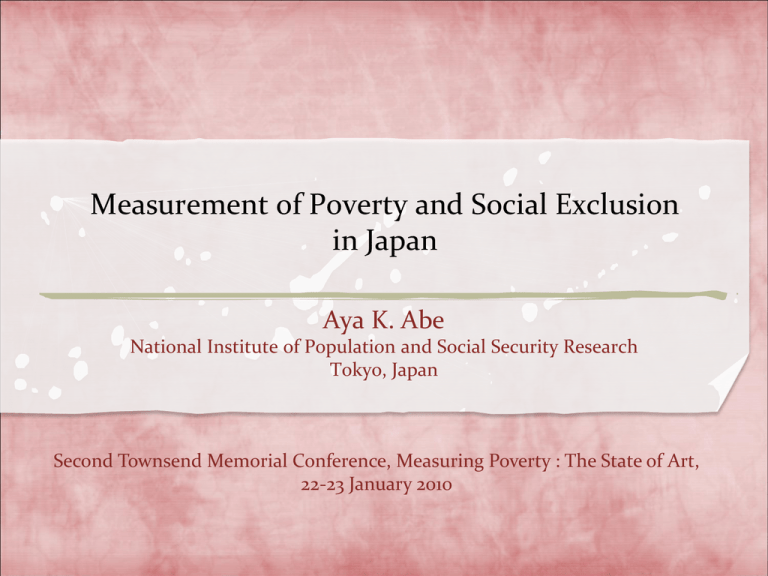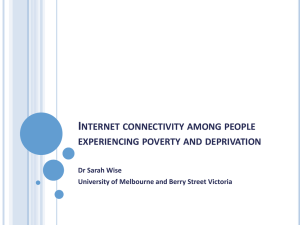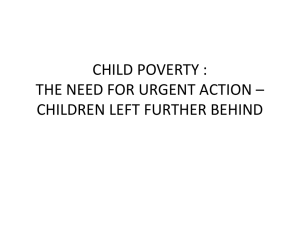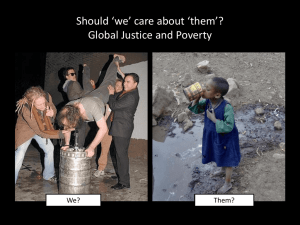
Measurement of Poverty and Social Exclusion
in Japan
Aya K. Abe
National Institute of Population and Social Security Research
Tokyo, Japan
Second Townsend Memorial Conference, Measuring Poverty : The State of Art,
22-23 January 2010
Poverty Rates of OECD countries(Mid 2000s)
Poverty Rates of OECVD Countries (Mid 2000s) :
Income measure
Data: OECD(2008) Growing Unequal?
Political Context
Upto 2008 :Denial stage
Oct. 2009: Announcement of Relative
Poverty Rate
Jan. 18, 2011:
Social
Inclusion Special Team established
under Prime Minister’s Office
From Research community
Up to 2000’s: some qualitative
research on special risk groups, such
as homeless population, singlemothers, etc.
From 2000’s: Some attempts to
calculate extent of poverty among
general population using large surveys
(mostly income) (Abe 2005,
Komamura 2005, etc.)
Brief Introduction of my work
2003 Necessities Survey (n=1350)
2003 Social Living Survey (n=1520)
Asking general public what is “necessary”
Using above items regarded “necessary”, asked who
are deprived of those items + some social network
questions
2006 Living Conditions Survey (n=584)
Asked Deprivation and social exclusion; more
emphasis on social exclusion
Sample limited to one geographical area near Tokyo
2008 Social Living Survey (n=1021)
2003 and 2006 survey questions combined, covered
all areas of Japan
2008 Necessities Survey for Children
Methodology:Defining Essentials and
Identifying Who is Deprived
Is it essential?
Yes
Do you have it?
No
Yes
No
Do not
want it
Cannot
afford it
Socially Perceived Necessities
in Japan
Data
The 2003 Necessities Survey
Sample of 2000 adults (20 years +),
randomly chosen from residents’ register all
over Japan
1350 responses (response rate = 67.5%)
For 28 items, asked respondents whether
they thought it is “necessary” to live
normally in Japan
% of support for items
%answering
"Definitely
" wtd
Items
Multiple bedrooms (for families larger than a couple)
Celebrating a birthday
Pocket money
Bicycle (or tricycle)
Mobile phone (incl. PHS)
Items
1
2
3
4
5
6
7
8
9
10
11
12
13
14
15
16
17
18
19
20
21
T o be able t o se e a do c t o r
To be a bl e to s ee a denti s t
Tel ephone
Pens i on premi ums to prepa re f or reti rement
Ins ura nce f or dea th, a cci dents , i l l nes s , etc.
E duca ti on upto H i g h s chool l ev el
F a mi l y 's ow n ba th ( i nc. s how er)
H ea ters /Cool ers ( a i r condi ti oner etc.)
B ook s , ma g a zi nes f or chi l dren
F a mi l y 's ow n toi l et
F a mi l y 's ow n k i tchen
H ot w a ter hea ter ( f or k i tchen a nd w a s h ba s i n)
A ttendi ng rel a ti v e's w eddi ng s , f unera l s , etc.
( i ncl udi ng g i v i ng g i f ts )
Mi cro-w a v e ov en
Tra ns porta ti on cos t to s ee f ri ends , f a mi l y , rel a ti v es .
N ew underw ea r a t l ea s t once a y ea r
Sepa ra te bedroom f rom the l i v i ng s pa ce
Pa rents pa rti ci pa ti ng s chool ev ent
To be a bl e to s a v e ev ery months ev en a l i ttl e
Speci a l s ui ts f or occa s i ons ( f unera l s , w eddi ng s , etc.)
Suits for work and interviews
88.6%
86.8%
86.6%
74.0%
71.9%
71.7%
67.1%
66.9%
66.8%
65.8%
64.9%
64.5%
58.5%
57.9%
57.8%
57.5%
56.9%
55.8%
54.4%
50.3%
49.5%
22
23
24
25
26
27 New Year's celebration(such as Osechi - a special meal for the
new year's day)
28
29
30
31
32
33
34
Xmas present
Child's own room
Education upto University or Junior university
Fruits at least once a day
Socializing with others through sports, hobbies
Video player
New clothes and shoes every year (not a second-hand)
35
36
37
38
39
40
41
42
Toys such as sports equipment and games
Participating neighborhood clubs, child clubs,
Eating out 2,3 times a month
Lessons (hobby, sports, etc.)
Family trip of more than 1 night at least once a year
Access to the internet
Juku (private tutoring classes)
Walkman, CD/MD Player, etc.
48.1%
47.2%
45.8%
44.7%
40.7%
35.7%
33.9%
33.7%
33.7%
33.6%
33.4%
31.5%
28.4%
26.1%
23.5%
22.6%
21.9%
20.8%
18.9%
16.2%
14.7%
% those who think the item is essential
Item
JAPAN
UK
Toys (that most of other kids have, such
as dolls, blocks, soccer ball, baseball etc.) 12.4%
84%*
Bicycle (including second-hand)
20.9%
55%
At least one pair of shoes (not secondhand)
40.2%
94%
Clothes (not second-had)
33.7%
70%
Own books
51.2%
89%
86.1%
Australia
94.7%**
To be able to go to dentists (including
check-ups)
* UK question: “Toys (e.g. dolls, teddies)
** Australia : Community Understanding of Poverty and Social Exclusion Survey 2006 in Saunders et al.
(2007)
Data: Japan Child Necessity Survey 2008 in Abe (2008), UK Office for National Statistics Omnibus Survey
1999, in Gordon et al. (2000)
% supporting items: 1st vs. 5th quintile (income)
図5 「絶対に必要」とした人の割合:等価世帯所得
% saying
“Definitely required”: 1st quintile vs. 5th
第1五分位 vs. 第5五分位
quintile
1
0.9
quintile (richest)
第5五分位(最高)
th
5
Pension
Insurance
0.8
0.7
Savings
0.6
Family Own Toilet
0.5
0.4
Internet
0.3
0.2
Family Trip
0.1
0
0
0.1
0.2
0.3
0.4
0.5
0.6
第1五分位(最貧)
1st quintile
(poorest)
0.7
0.8
0.9
1
% supporting items: by education
% saying
“Definitely required”: College中卒
gradsvs.vs.大卒
図9 「絶対に必要」とする人の割合:
Mandatory education only
Suits
Dentist
Mobile
Internet
大卒
College or above (
12
+)
1
0.9
0.8
0.7
0.6
0.5
0.4
0.3
0.2
0.1
0
telephone
Wedding
Neighborhood clubs
0
0.1
0.2
0.3
0.4
0.5
0.6
0.7
0.8
中卒
Junior high school (9 yrs of education)
0.9
1
% supporting items: Women vs. Men
% saying “Definitely required”:
Women
女性
図17 「絶対に必要」とする人の割合:
men
vs. vs.
women
男性
女性
1
0.9
0.8
0.7
0.6
0.5
0.4
0.3
0.2
0.1
0
Microwave
Separate
bedroom
fruits
Mobile
Video player
0
0.1
0.2
0.3
0.4
0.5
Men男性
0.6
0.7
0.8
0.9
1
% supporting items: by location
Living in Village
町村
% saying図19
“Definitely
required”: those living in
「絶対に必要」とする人の割合:
village vs. those living
in large
cities
大都市
vs. 町村
1
0.9
0.8
0.7
0.6
0.5
0.4
0.3
0.2
0.1
0
wedding
寝室と食卓が別
冠婚葬祭
Dentist
冷房・暖房
Multiple bedrooms
複数の寝室
専用浴室
Neighborhood clubs
町内会などへの参加
Family’s own bathroom
ビデオ
家族旅行
Family trip
Internet
インターネット
0
0.1
0.2
0.3
0.4
0.5
0.6
13大都市
Living in Largest
13 cities
0.7
0.8
0.9
1
% supporting items: by Age
% saying 図15
“Definitely
required”: Above 70 years old
「絶対に必要」とする人の割合:
telephone
vs. Below 30 years
old vs. 70歳以上
30歳未満
1
0.9
0.8
70 0.7
0.6
0.5
0.4
0.3
0.2
0.1
0
Doctor
Above
医者
電話
Wedding
冠婚葬祭
70歳以上
years old
Neighborhood clubs
果物
地域社会に参加
年金保険
冷暖房
寝室と食卓別
正月祝
死亡保険
新しい下着
複数の寝室
貯金
スーツ
趣味の交流
家族旅行
Video pl.
外食
携帯電話
Mobile
ビデオデッキ
インターネット
Internet
0
0.1
0.2
0.3
0.4
0.5
Below 30 years
old
30歳未満
0.6
0.7
0.8
0.9
1
Patterns of Deprivation in
Japan
Data
2003 Social Living Survey
Sample of 2000 adults (20 years +),
randomly chosen from residents’ register all
over Japan
1520 responses (response rate = %)
Table 1
Socially Perceived Necessities and Their Diffusion Rate
Socially Perceived Item
Diffusion Rate
Household
Durables
Social
Activities
Social
Security
Housing
Conditions
Deprivation rate
Microwave oven
98.4%
1.6%
Heating and cooling equipment (air conditioners, gas or electric heaters,
kotatsu, etc.)
99.1%
0.9%
Water heating equipment
96.4%
3.6%
Attending family and relative's wedding/funerals/etc. (including travel and
gift expenses)
97.2%
2.8%
Telephone
Attire for special occasions (reifuku)
New underwear more than once a year
97.9%
97.2%
92.2%
2.1%
2.8%
7.8%
Being able to go to a doctor when needed
98.2%
1.8%
Being able to go to a dentist when needed
97.2%
2.8%
Being able to enrol in life, disability or sickness insurance
91.9%
8.1%
Being able to save for old age
Being able to save money every month
93.9%
75.0%
6.1%
25.0%
Have a toilet for the family's own use (not shared with other dwellings)
98.8%
1.2%
Have a kitchen for the family's own use (not shared with other dwellings)
98.9%
1.1%
Have a bathroom for the family's own use (not shared with other dwellings)
97.8%
2.2%
Have a bedroom different from living (eating) room
95.0%
5.0%
*Diffusion rate = the rate of those possessing the item among the entire sample minus those who do not want to
possess the item
* Deprivation rate = 100% - Diffusion rate
Table 2 Distribution of Deprivation Score
Score (X)
0
1
2
3
4
5
6
7
8
9
10
11
samle size
Average
Std.Dev.
n
990
312
80
61
27
17
13
10
6
2
1
1
1520
0.713
1.403
%
65.1%
20.5%
5.3%
4.0%
1.8%
1.1%
0.9%
0.7%
0.4%
0.1%
0.1%
0.1%
% lacking
Accumulative
more than X
%
items
65.1%
85.7%
90.9%
94.9%
96.7%
97.8%
98.7%
99.3%
99.7%
99.9%
99.9%
100.0%
34.9%
14.3%
9.1%
5.1%
3.3%
2.2%
1.3%
0.7%
0.3%
0.1%
0.1%
Table 3 Deprivation rate of Different groups
Entire sample
Low-income households (*1)
Age of Household Head
20s
30s
40s
50s
60s
Over 70
Marital Status
With Spouse
Without Spouse
Female with spouse
Female without spouse
Male with spouse
Male without spouse
Deprivation rate
n
1520
34.9%
350
50.3%
76
218
303
358
343
222
1239
281
401
177
832
104
52.6%
32.1%
35.0%
32.1%
31.5%
41.0%
31.6%
49.1%
30.2%
49.2%
32.6%
49.0%
χ2
47.62
17.87
***
***
30.79
***
19.20
***
11.47
***
*1 Households with incomes less than 50% of median income
*2 Households with only one person
*3 Households with household head aged more than 60 years old
*4 Households which has one or more disabled person
*5 Households which has one ore more children aged less than 16
*6 Households which has one ore more children aged less than 16, and
whose household head is single
20s with spouse
20s without spouse
30s with spouse
30s without spouse
40s with spouse
40s without spouse
50s with spouse
50s without spouse
60s with spouse
60s without spouse
Over 70 with spouse
Over 70 without spouse
Single household (*2)
Single female household
Single male household
Elderly household (*3)
Single elderly household
Single female elderly household
Single male elderly household
Disabled household (*4)
Household with children (*5)
Single-mother household (*6)
54
22
186
32
258
45
297
61
275
68
169
53
118
74
44
533
55
41
14
67
435
19
51.9%
54.5%
28.5%
53.1%
31.4%
55.6%
29.0%
47.5%
28.0%
45.6%
39.6%
45.3%
56.8%
54.1%
61.4%
34.3%
58.2%
56.1%
64.3%
61.2%
36.6%
73.7%
0.05
7.60
***
9.83
***
8.02
***
7.82
***
0.53
27.05
12.03
15.16
0.10
13.66
7.75
5.72
20.99
0.76
12.76
***
***
***
***
***
**
***
***
Graph 1 Average Relative Deprivation Index by Income Strata
0.2
0.18
0.16
Deprivation Index
0.14
0.12
0.1
0.08
0.06
0.04
0.02
0
0
200
400
600
800
1000
1200
Income(10,000yen)
1400
1600
1800
2000
Graph 2 Frequency of deprivation: working age vs. elderly
1.2
Working Age
1
Deprivation Rate
Elderly
0.8
0.6
0.4
0.2
0
0
200
400
600
800
1000
Income (10,000 yen)
1200
1400
1600
Graph 3 Depth of Deprivation: Working age vs. Elderly
(Average Deprivation scale for those whose Dep.Scale > 0)
Average deprivation scale
0.25
Working age
0.2
Elderly
0.15
0.1
0.05
0
0
100
200
300
400
500
600
Income (10,000 yen)
700
800
900
1000
Comparison of Japan-Australia
Deprivation patterns
Why Deprivation approach?
Assumption that most households consist of
nuclear families- Not the case in Japan -> raises
questions re: equivalence adjustment
Presence of multi-generational hh
Deprivation approach: direct measurement of living
standard, not relying on assumptions on resource
sharing within families
Slides 25-XX: Saunders, Peter & Abe, Aya. 2009. “Poverty and Deprivation
in Young and Old: A Comparative Study of Australia and Japan.” Poverty and
Public Policy, Vol.2, Iss.1, Article 5 (2010).
Comparison of Japan-Australia
Deprivation patterns
Australia
Japan
Community Understanding
The Social Living Survey,
of Poverty and Social
2003, NIPSSR (Abe 2006)
Exclusion (CUPSE) survey,
2006, Social Policy
N=1,520
Research Centre
(Saunders, Naidoo and
Griffiths, 2007).
N=2,700
Difficulties
Do we use the same list of items?
-> how do we account for differences in
what is considered “necessary”?
Do we use the items selected using the
same methodology?
What UNIT of comparison do we use?
Table 4: The Overall Incidence of Deprivation (unweighted percentages)
AUSTRALIA
Domain/Item
Health/Basic Needs
Medical treatment if needed
Dental treatment if needed
Able to buy prescribed medicines
Warm clothes and bedding
A substantial daily meal
Accommodation/Facilities
A decent and secure home
Secure locks on doors & windows
Roof and gutters that do not leak
Furniture in reasonable condition
Heating in at least one room
A washing machine
Home contents insurance
Security/Risk Protection
Up to $500 in emergency savings
Full motor vehicle insurance
JAPAN
Incidence
(%)
2.0
13.9
3.9
0.2
1.1
6.6
5.1
4.6
2.6
1.8
0.8
9.5
17.6
8.6
Domain/Item
Health/Basic Needs
To be able to see a doctor
To be able to see a dentist
New underwear at least once a year
Accommodation/Facilities
Family's own toilet
Family's own kitchen
Hot water heater (for kitchen)
Family's own bath (inc. shower)
Heaters/coolers
Micro-wave oven
Separate bedroom from living space
Security/Risk Protection
Pension premiums for retirement
Insurance for death, illness, etc.
To be able to save every month
Incidence
(%)
1.8
2.7
7.4
1.2
1.1
3.4
2.2
0.9
1.5
4.9
4.1
7.8
25.0
Children’s Needs
Up to date school books & clothes
Children participate in school
Annual
check for children
activitiesdental
and outings
A hobby/leisure activity for children
A separate bed for each child
A separate bedroom for older
Social
childrenFunctioning
Telephone
Regular social contact with others
3.8
3.5
5.7
9.1
1.6
Children’s Needs (a)
Education to High School level
Books, magazines for children
Parents participating in school
events
0.6
0.3
0.6
6.1
1.5
Social Functioning
Telephone
Attending relative's weddings,
2.0
4.7
funerals, etc. (including giving gifts)
2.8
Special suits for funerals, weddings,
A television
0.2
etc.
Presents for family or friends
6.6
Computer skills
5.2
Week's holiday away from home
22.4
Mean Incidence rate (unweighted)
5.8
(a) For Japan, the children’s needs were asked only to households with children aged 12 an
2.4
4.1
Table 1: Household Types and Sample Composition
Australia
Household type
Japan
Sample size
%
Sample size
%
Single, working-age (WA; 20-64)
202
8.0
66
4.4
Single, older person (OP; 65+)
158
6.2
43
2.8
Couple and other adults, head is
942 (502)
37.1
692 (463)
45.7
390 (309)
15.3
282 (137)
18.6
736 (576)
29.0
414 (331)
27.3
113
4.4
17
1.1
2,541
100.0
1,514
100.0
WA, no children (a)
Couple and other adults, head is
OP, no children (a)
Couple and other adults, head is
WA, with children (a) (b)
Sole parent, WA with children
Total
Notes: (a) Numbers in brackets refer to couples only (i.e. no other adults living in the household); (b)
This group contains a small number of households (15 in Australia and 6 in Japan) where the head is an
older person.
Table 6: Deprivation Indicators by Household Type
AUSTRALIA
JAPAN
Household
Mean
Mean
type
score
D=0
D≥1
D≥2
score
D=0
D≥1
D≥2
(MDS)
(%)
(%)
(%)
(MDS)
(%)
(%)
(%)
Single, working-age (WA)
2.1
4.8
5.2
3.9
1.80
3.8
6.2
3.3
Single, older person (OP)
1.3
6.2
3.8
2.7
1.35
4.4
5.6
2.6
1.1
6.6
3.4
2.3
0.59
7.1
2.9
1.1
0.6
7.5
2.5
1.4
0.58
6.4
3.6
1.1
1.4
6.0
4.0
2.7
1.41
6.5
3.5
1.6
3.9
2.6
7.4
5.9
2.65
1.8
8.2
6.5
1.3
6.2
3.9
2.7
0.73
6.5
3.5
1.5
Couple and other adults, head
is WA, no children
Couple and other adults, head
is OP, no children
Couple and other adults, head
is WA, with children
Sole parent, WA with
children
Total
Notes: See Notes to earlier Tables.
Comparison by Household Type:
Similarities
The number of items differs between JP
and AUS, thus comparison of the
absolute values of MDS or % of
deprivation do not mean much. Instead,
we need to look at patterns and ordering
of family types within each country.
Similarities: Sole parents are the most
deprived, followed by WA singles, WA
with children. Least deprived are older
couples, WA couples w/o children, older
singles.
①
②
③
④
⑤
Comparison of hh types: remarkably
similar
Elderly single vs. WA single
(AUS)
<<
(JP)
<<
Elderly single vs. Elderly couple
(AUS)
>>
(JP)
>>
WA single vs. WA couple w/o children
(AUS)
>>
(JP)
>>
WA couple with children vs. WA couple w/o children
(AUS)
>
(JP)
>>
WA couple with children vs. Lone parents
(AUS)
<<
(JP)
<<
Table 7: Overlap Analysis and Consistent Poverty (percentages)
Neither
Neither
Poverty
Deprivation
P and
P nor
rate
rate (D)
P and
P nor
(D ? 2)
D
D
(P)
(D ? 2)
D
D
17.7
32.3
13.9
62.9
10.8
39.7
8.2
57.7
11.6
29.5
7.8
66.7
25.7
20.0
11.4
65.7
Poverty
Deprivation
rate
rate (D)
(P)
(WA)
Single, older person
type
JAPAN
AUSTRALIA
Household
Single, working-age
(OP)
Couple and other
13.8
23.8
7.7
70.2
11.2
11.2
4.3
81.9
23.1
14.9
7.0
69.0
20.4
11.0
4.5
73.1
11.5
26.0
7.0
69.0
12.3
16.6
6.1
77.3
children
22.4
57.9
14.0
33.6
47.1
64.7
41.2
29.4
Total
14.5
26.4
7.7
66.8
14.3
14.6
5.9
77.0
adults, head is WA,
no children
Couple and other
adults, head is OP, no
children
Couple and other
adults, head is WA,
with children
Sole parent, WA with
Notes: See Notes to earlier Tables.
Overlap analysis
Le us define Low income & D<=2 to
be consistent poverty
Aus: Consistent poverty is spread
evenly at around 8% across all
households (except sole parent hh).
Jp: the differential is very large across
different household types; strikingly
high in elderly singles & sold parents
Conclusion: Aus-Jap comparison
The ranking of poverty as measured by
income differs between AUS-JP, but it is
very similar if poverty is measured by
deprivation.
Perhaps
deprivation captures the “real”
occurrence of poverty which is shared among
countries?
From the overlap analysis, consistent
poverty is more concentrated in Japan.
Measuring Social Exclusion in
Japan
Data
The 2006 Living Conditions Survey (LCS)
Sample of 1600 adults (20 years +),
randomly chosen from the residents’
register in the southern Kawasaki City
Kawasaki is located between Tokyo and
Yokohama, a part of industrial belt.
The southern part host many factories, and the
city received influx of migrant laborers from
rural sections of Japan.
584 responses (response rate = 36.5%)
Survey Concept
It should capture economic impoverishment not only by income,
but also by material deprivation
It should capture how an individual is excluded (forced out) from
various public constructs within a society, e.g. public schemes such
as public pension and public health insurance, public services such
as transportation and utilities, and public spaces such as libraries
and sports facilities
It should capture exclusion from private spheres, e.g. lack of social
relations (communication with others, meeting family obligations,
doing activities with others) and social networks (support in need)
it should measure degree of individual’s involvement with society,
e.g. social participation such as participation in local communities
(neighborhood organizations, women’s clubs, PTA, etc.), civic
activities (voting, political involvement, etc.), and personal
communities (alumni clubs, sports and hobby circles, etc.)
These should enforced lack, rather
than preference.
It should not only capture the
enforced lack due to economic
constraints, but also due to other
constraints (health, family, work,
social, etc.), and should be able to
distinguish them
8 dimensions chosen
(lack of ) basic human needs,
2. material deprivation,
3. exclusion from systems and services,
4. (lack of) leisure and social participation,
5. inadequate housing,
6. (lack of ) social relation,
7. subjective poverty, and
8. income poverty
1.
Almost all items were asked whether
they “are wanted but cannot be
obtained”, “not wanted (or not
interested)” or “are obtained”.
For most of items, the survey also asks
“the reason” why that item cannot be
obtained : Economic, family, work,
health, other reasons.
Example: Social Participation
Family
Economi
Health Other
or work
c Resons
Reasons reaons
reasons
6 . Lack of Social Participation
Holiday
Less than 1 overnight family trip a year (exludes not interested)
35.1%
16.4%
Eating out
Less than 1 eating-out a month (exludes not interested) 37.4%
Social activities
Cannot participate in more than 1 item among 6
below (excludes not interested)
66.1%
Neighborhood groups, PTA, women's or senior groups
38.6%
Volunteer and charity activities
18.4%
5.0%
5.0%
1.7%
23.4%
5.9%
9.3%
49.1%
2.6%
31.0%
7.2%
10.3%
Hobby or sports
26.2%
3.3%
16.5%
5.9%
3.3%
Religious groups
6.9%
0.5%
2.2%
1.6%
2.1%
Political groups
12.2%
1.4%
5.0%
3.1%
3.3%
Labor unions
20.6%
1.2%
6.8%
2.6%
9.3%
Very few indicate economic reasons for not
being able to participate in social activities
Family/Work reasons is most often cited.
Social Exclusion Indexes
SocialExclusion
Indexes
(standarized)
D im ensions
Lack of B asic Needs
M aterial Deprivation
Exclusion from System s
Lack of SocialParticipation
H ousing D eprivation
Lack of SocialR elations
Subjective Poverty
Incom e poverty
n
584
584
584
584
584
584
584
456
# item s Average Std.Dev.
3
10
10
9
6
8
3
1
0.106
0.022
0.141
0.075
0.061
0.247
0.237
479.8
0.227
0.095
0.173
0.166
0.139
0.210
0.310
338.457
Percentage of
Respondents who are
Excluded
Threshold
(# item s)
1
1
4
4
2
4
2
198
%
20.9%
9.9%
11.0%
10.8%
11.8%
17.6%
18.0%
11.6%
Threshold for determining those who are "excluded" are
decided by the author so that the exclusion rate will be 10 to
20% of the respondents.
Example: Exclusion from Systems
Family
Economi
He alth Other
or work
c Resons
Reasons reaons
reasons
3 . Exclusion from Systems
1) Vo ting in Elections
"Never""Almost none" ( total 16.8% ) , except those
who are not interested (9.6%)
7.2%
2) Pension Insurance
Not subscribing to either public nor private pension
9.2%
3) Health Insurance
Not subscribing to either public no r private health
insurance
4.3%
4) Public Service
facilities
and
Cannot use at least 1 of below services and facilities
45.2%
Economi
c Resons
Public libraries
Public sports facilitie s (public pool, etc.)
25.4%
32.4%
7.6%
16.5%
14.2%
10.7%
4.0%
7.0%
0.0%
1.5%
0.0%
0.0%
0.2%
0.2%
0.2%
7.0%
Public offices
Public health centers
Community centers, chonaikai centers, etc.
Public parks
Public transportation (bus, train, etc.)
5) Public utilities
4.0%
Utilieis (Electricity, Gas, Water)
1.4%
1.9%
Access or
He alth Other
facility
Reasons reaons
reasons
11.6%
16.1%
2.6%
4.5%
5.1%
4.1%
0.9%
2.2%
4.5%
1.2%
2.1%
2.2%
2.1%
1.0%
11.6%
10.3%
3.8%
9.9%
6.7%
4.3%
1.9%
Almost none stated economic reasons
“Access” is most often cited reason.
Share of Respondents Excluded, by key social variables
n
Income
Poverty
Lack of Basic
Needs
Material
Deprivation
Housing
Deprivatio n
Subjective
Poverty
Exclusion from Lack of Social Lack of Social
Syste ms
Participation
Relations
584
290
294
0.116
0.117
0.116
0.209
0.228
0.190
0.099
0.114
0.085
0.118
0.114
0.122
0.180
0.224 **
0.136
0.110
0.093
0.126
0.108
0.152 ***
0.065
0.176
0.200
0.153
113
105
0.137
0.082
0.195
0.210
0.097
0.124
0.168 *
0.095
0.106 *
0.190
0.106
0.105
0.106
0.076
0.097 **
0.124
60-69
87
100
96
0.059
0.092
0.111
0.149
0.230
0.271
0.069
0.110
0.104
0.092
0.180 *
0.083
0.241
0.260 **
0.177
0.080
0.080
0.083
0.149
0.260 **
0.094
0.126
0.160 *
0.188
Over 70
83
0.226 ***
0.193
0.084
0.072
0.108 *
0.217 ***
0.289 ***
0.060
12
11
0.571 ***
0.000
0.250
0.182
0.000
0.182
0.083
0.273
0.167
0.091
0.023
0.130
0.116
0.093 *
0.407 ***
0.157
0.395 ***
0.370 ***
0.041 ***
0.023 **
0.222
0.182
0.163
0.074
0.083
0.000
0.273 *
0.047
0.278 ***
0.083
0.083
0.273
43
54
121
0.000
0.273 *
0.163
0.259 ***
0.083
361
98
0.069 ***
0.136
0.188
0.214
0.097
0.061
0.122
0.071
0.202 *
0.102 **
0.097
0.082
0.116
0.071
0.158
0.133
36
86
0.083
0.295 ***
0.167
0.291 **
0.056
0.174 **
0.028 *
0.186 **
0.174
0.221
0.056
0.209 ***
0.000 **
0.151
0.194
0.302 ***
95
185
44
0.194 **
0.113
0.086
0.326 ***
0.238
0.182
0.179 ***
0.124
0.045
0.189 **
0.103
0.045
0.253 **
0.200
0.159
0.158 *
0.119
0.045
0.147
0.097
0.114
0.326 ***
0.168
0.159
103
138
0.092
0.092
0.175
0.116 ***
0.068
0.065
0.107
0.123
0.136
0.145
0.117
0.065 ***
0.117
0.094
0.146
0.094 ***
Overall
Men
Women
(*1)
Age Group :
20-29
30-39
40-49
50-59
Household Type:
(* 1)
Single Elderly Wome n
Single Elderly Men
Single Working Age Women
Single Working Age Men
Households with Children
(*2)
Working Status
Working
Not Wo rking (Housewife)
Not Wo rking (Retired)
Not Wo rking (other)
0.116
0.222
0.107 **
Education :(*3)
Junior High School
High Schoo l
Specialty school
Junior College
College
Some Key findings
(Gender)
Men show higher rate of exclusion than women (lack of
social participation and subjective poverty)
Same as PSE (social participation), but even more so.
(Age Group)
The income poverty shows an U shape curve, but it does
not seem to translate directly to Lack of Basic Needs and
Material Deprivation.
Those at 50’s seem to be at higher risk of many
dimensions of S.E., e.g. Housing, Subjective poverty,
Lack of Social Participation, Lack of Social Relations
Concurs with the fact that the suicide rate for men peaks
at age 50-59. & 95% of homeless persons are men, a half of
which are in their 50s.
(Household type)
Working age single-person households are by far the most at
risk of social exclusion: Basic Needs, Material deprivation,
housing deprivation, and lack of social participation
(Working Status)
Not being in the labor force, by itself, does not seem to
indicate higher risk of social exclusion.
In fact, housewives and retired persons are at lower risk of social
exclusion in some dimensions (subjective poverty, housing, social
partipation)
However, not-being in the labor force for other reasons does
indicate higher risk of social exclusion in 6 dimensions,
including non-financial dimensions such as Exclusion from
Systems and Lack of Social Relations. Involuntary
detachment from the labor force is associated with social
exclusion.
(Education Level)
Low education attainment (up to Junior high school =
age 15, the compulsory education in Japan) is a strong
link to social exclusion, not only for financial
dimensions (income poverty, lack of basic needs,
material deprivation, housing deprivation), but also for
non-financial dimension s (exclusion from systems, lack
of social relations).
High education attainment (college+) is associated with
lower risk of social exclusion (systems, and basic needs)
Social Exclusion and Earlier
Disadvantages
Outside Japan, there are many studies linking
childhood poverty to adult outcomes.
However, in Japan, there are very few studies
connecting earlier life disadvantages and poverty
and/or social exclusion, since there has not been much
accumulation of panel data sets.
The studies using the Japanese Panel Survey of Consumers
(JPSC) , the only long enough panel data set, has shown those
who divert from “standard life course”, such as those who
divorce and who do not marry, are more prone to becoming
poor (Iwata & Nishizawa 2005). However, JPSC only covers
women in a certain cohort.
This Study
The survey was designed to capture major
disadvantageous events (Independent
variables): childhood poverty, divorce,
prolonged illness or injury, involuntary lay-off.
Outcome (Dependent) variables include both
financial poverty as well as social exclusion.
Control variables are : current income, sex, age
class, single-elderly, current household type
(has children, single-person household),
current working status.
Results of Regression for Social Exclusion Indexes
Lack of Basic
Needs
Equiv.HH Income
Sex (M=1, F=0)
20-29 yr old (*1)
40-49 yr old (*1)
50-59 yr old (*1)
60-69 yr old (*1)
70-79 yr old (*1)
Over 80 yrs (*1)
Single-person Household
Housing
Subjective
Poverty
-0.0212 *** -0.0034 **
0.0178
-0.0024
-0.0050
-0.0170 *
-0.0053 *
-0.0277 **
-0.0079
-0.0455 ***
0.05808 **
-0.082 *
-0.0006
-0.0239
0.0122
-0.0091 *
0.02293
-0.0219
-0.0084 **
0.04411 ***
0.0072
-0.0399
-0.0089
-0.0125
-0.0233 **
-0.0202 *
-0.0135
-0.0190
0.0002
-0.0166
0.0301
0.0848 *
-0.0166
-0.0543 *
-0.0276
-0.0371
-0.0538
0.0445
-0.069 *
0.0093
0.0163
-0.0157
0.0052
-0.0750
0.0299
0.0089
-0.0243
0.0246 **
-0.0008
-0.0429
0.1034 ***
0.0130
-0.0910
0.0090
0.0367
0.0602
-0.0077
0.0747 *
0.1111 *
-0.0158
0.0014
-0.0809 *
0.0356 *
-0.0289
0.0098
-0.0007
0.0013
-0.1164 ***
0.0073
0.0041
0.0051
0.0851
0.0388
-0.0059
-0.0041
0.0298
0.0429 **
0.0213
0.0533 ***
0.0397
0.0396
-0.0132
0.0097
0.0397
-0.0071
-0.0154
-0.0050
-0.0395
Work Status(Working=1, NW=0)0.0062
-0.0256
Living with Children
-0.0019
Experienced Sickness and Injury
Single Elderly
Experienced Divorce
Experienced Lay-Off
Living status at Age 15
Intercept
Adj.R2
Material
Deprivation
Exclusion Lack of Social Lack of Social
from Systems Participation
Relations
0.0727 *
-0.0061
0.0444
0.0348 ***
0.1346 *** 0.0082
0.0616 ***
0.0686 ***
0.0204
0.0354
0.1546 ***
0.0119
0.0389
0.0515 **
-0.0027
0.0343
-0.0295
0.0844 *** 0.0449 **
0.0453
0.0305
0.14645 *** 0.02554
0.0815
0.0453
0.05771 ***
0.1624
0.3003 ***
0.1115
0.10824 ***
0.0311
0.22127 *** 0.06733 ***
0.0754
0.0423
(*) Asterisk represents results of chi-square statistics of the group and all others. :
*** statistically significant at 1%, ** at 5%, * at 10%
(*1) base 30-39 yr old
Key Findings
(Lay-off)
Having experience of a lay-off has positive and
significant effect on current material deprivation,
housing deprivation, lack of social participation, lack of
social relations, exclusion from systems and subjective
poverty, even after controlling for current income, age,
sex, working status, and household type.
(Divorce)
Having experience of divorce has positive and
significant effect on basic needs and housing
deprivation, even after controlling for current marital
status (single-person hh).
Key Findings
(Prolonged illness and injuries)
Having experience of prolonged illness and injuries
(which caused one to be out of work or school for more
than one month) has positive and significant effect on
exclusion from systems.
(Childhood poverty)
Having experienced childhood poverty (living standard
at age 15 was “very low” (=1) out of scale of 5) has
positive and significant effect on current lack of basic
needs, even after controlling for current income, age,
household type and other disadvantages such as divorce
and lay-offs.
The causal relationship is indicated.
(Control variables)
Income: Negative and significant in all but one (systems
exclusion), including social relations and participation.
Gender: Men are + *** (social relations, subjective poverty)
Age: does not seem to have that strong of a effect
Work sattus: + ** (Exclusion from systems) ??
Conclusions
Sections of population most vulnerable to income poverty is
not most vulnerable to social exclusion.
Possible “new” vulnerable group: men in their 50s.
Disadantages in earlier stages of life seem to exhort influences
on some aspects of current social exclusion, even after
controlling for current income, work status, household type,
etc.
The catch-phrase of the former PM Abe “a society in
which one can re-challenge” DOES NOT seem to hold.
Childhood poverty seems to have irrevocable
continuing effect on adult well-being not only via
education and occupation (and thus income), but
by another path.









